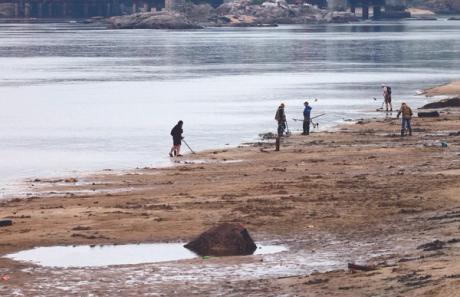
A July 19 report based on “high-resolution satellite images” confirms flooding next to self-taught Ukrainian artist Polina Rayko’s house-museum in Oleshky, Ukraine, following the destruction of the Nova Kakhovka dam last month.
Russia seized the strategic Dnieper Dam on February 24, 2023, the day it invaded Ukraine. The Conflict Observatory, which published the report, is an independent project launched by the US State Department, which has since been monitoring the damage and destruction of cultural heritage sites in Ukraine through the work of the Yale School of Public Health’s Humanitarian Research Laboratory, the Smithsonian Cultural Rescue Initiative and PlanetScape Ai.
Katharyn Hanson, head of research at the Smithsonian Cultural Rescue Initiative (SCRI) at the Smithsonian Institution, says The arts journal that information collected by participating organizations, including the Ukrainian Heritage Monitoring Laboratory (HeMo), reduced “the lead time in order to focus our analysis of the satellite images”. He confirmed the report on the ground of the damage caused by the floods via photos and videos made by the Polina Rayko Foundation.
“We hope our satellite images in this report will provide additional information, documentation and possible future evidence of flood damage” at the Polina Rayko Museum, Hanson said.
In the report, satellite images marked with yellow arrows “show the museum and surrounding neighborhood inundated by water” on June 7. The home of Rayko, who died in 2004, was decorated with his artwork depicting flora, fauna, family members, and religious motifs on every wall.
HeMo continues to document “ground damage where possible and safety can be assured,” Hanson said. The flood severely affected Russian-occupied Ukrainian territory, including Oleshky. The Conflict Observatory’s research follows a “rigorous chain of custody procedure for future civil and criminal legal proceedings in the appropriate jurisdictions” as cases of war crimes trials against Russia mount.
Ukraine’s cultural heritage faces daily threats. Three museums in the historic port city of Odessa on the Black Sea have been damaged by Russian bombing this week. The city’s historic center was granted UNESCO World Heritage status earlier this year.
Disputes over the funding of wartime culture have divided Ukrainian leaders. Culture Minister Oleksandr Tkachenko tendered his resignation on Thursday, saying in a Facebook post that culture is no less important than drones since “culture is the shield of our identity and our borders”.
Meanwhile, Ukrainian President Volodymyr Zelensky said in his nightly address to the nation that although culture is important, “now there are other priorities”.
Heritage sites were immediately flagged as being at grave risk following the disastrous dam burst on June 6, as archaeological artefacts were submerged in water and illegally excavated.
The disaster destroyed homes, forced the evacuation of thousands of people and caused enormous environmental damage. President Zelenskiy blamed Russia for the disaster, describing it as “an environmental bomb of mass destruction”, while Russia claimed Ukraine was responsible. The dam is under Russian control and therefore inaccessible to independent investigators, although growing evidence suggests a deliberate explosion.
In the days after the dam burst, Khortytsia National Reserve warned of a “boom” in “black archaeology” on the park’s island grounds and called on the public to alert them to “anyone with metal detectors or digging on the land.” In a Facebook post, the reserve said visitors who found artifacts should “send us a photo with geotagging or bring [them] to the museum, so you can keep it for future generations.
The Ukrainian administration of the Kherson region, part of which is occupied by Russian forces, has also launched a public appeal describing the significant threat to archaeological research in the area. Artifacts from “unexplored mounds” in Kherson Oblast were “washed from the ground and carried along the banks of rivers and the Black Sea by a powerful current,” the administration said. “If you notice such objects, please contact the Kherson Regional Museum of Local History immediately.”
A few days earlier, while rescuing freshwater turtles from seawater, rescue workers in Odessa came across a historic amphora floating in the water, most likely swept away by floodwaters. They handed it over to the Kherson Museum, which described the find “like a great joy”
The Ministry of Culture and Information Policy of Ukraine reported that to June 13, 147 cultural institutions in the Kherson and Mykolaiv regions were threatened, “taking into account the territories temporarily not controlled by Ukraine”, and 20 were in directly flooded areas. Immediately after the dam broke, the ministry published a list of the most severely affected museums in and around the town of Nova Kakhovka, where the dam is located. Most, with the exception of a Cossack history museum in the village of Kozatske, are in occupied territory.
Kilian Heck, art historian at the University of Greifswald in Germany, who participated in the creation of the Ukraine Art Aid Center network of art historians and experts in 2022 and recently published a anthology of Ukrainian art, says that the destruction of the dam “means a catastrophe for many cultural properties in southern Ukraine”. At risk are “hundreds of kurgans [ancient burial mounds] from the time of the Scythians”, and the archaeological sites of the regions of Zaporizhzhia, Kherson and Mykolaiv, which are “currently tormented by robbers and grave robbers”.
